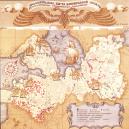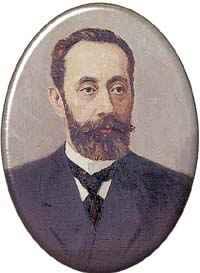Articles
/
Neolithic monuments, The
Neolithic monuments, The
Subject /
Relics
The Neolithic monuments. The Neolithic (New Stone Age, 8000 - 3000 BC) is the epoch of farming and cattling appearance, spinning and weaving, new techniques of processing of stones and ceramics. In the Eastern Europe forest zone the Neolithics is dated from 5000-2000 BC and characterized by stable fishing and hunting. Sites related to the Narva Culture appeared in the south of the modern Leningrad Oblast and in the southern Ladoga Lake region in the early Neolithic period. The lower lay of Syaberskaya 3 site in the Luga district (the excavations of V.I. Timofeyev, 1988-1989) is accepted as the standard of the northern variant of this culture. Narva ceramics and bone items were found at the Berezye site complex of the Volkhov district too. Thin-walled pots were made of narrow clay bands with the admixture of organic remains and crushed shells. The top part of pots were decorated with rare ornamental pattern as horizontal rows of inlays, pits, pinholes, impressions. Combers of the surface made by a comb stamp are typical for these pots. Silicon tools were not much. A number of finds, collected during building the New Syas Canal, are the part of "The Collection of A.A. Inostratsev". The Narva Culture verges on the early Sperrings Neolithics Culture which areal was located in the territory of Finland and Karelia. Finds of the type ceramics are presented at the archaeological sites of the Karelian Isthmus, the southern Ladoga Lake region and the eastern pert of the oblast. Ceramics, closed to early stages of the Valday and Upper Volga cultures, were found among finds at the site of Zabelye of the Leningrad Oblast (excavations of Yu.N. Urban, 1987). The Baltic Culture with the Pit-and-Comb ceramics was formed on the oblast territory in the epoch of the developed Neolithics. This type of ceramics was picked out by A. Evropeus. The prevalence of the comp stamp impressions covering the surface of big semi-egg-shaped pots is typical for this type of ceramics. Impression zones are separated by rows of deep pits. There are geometrical figures and horizontal zigzags, specific impressions and notches in the pattern. Besides ceramics, plenty of silicon tools, series of items made of quartz are typical for the sites. There are finds of the eastern Baltic amber decorations. The radiocarbon analysis gives the notion about the age of items with the comb-and-pit ceramics: early items are dated from the late 4000 BC, the latest items are dated from the late 3000 - early 2000 BC. The settlement Ust-Rybezhna 1 located at the confluence of the Rybezhka and Pasha rivers (excavations of N.N. Guriba, 1952-1954, 1956, 1958-1959) is accepted as the sample monument of the Neolithics Culture. Its culture lay is remarkable for the good undamaged state. There are many known sites in the Ladoga Lake region, on the Karelian Isthmus, in the western districts of the oblast, and in the Luga district.
Authors
Plotkin, Konstantin Moiseyevich
Persons
Europeus-Aekapaa A.
Gurina, Nina Nikolayevna
Inostrantsev, Aleksandr Aleksandrovich
Timofeyev, Vladimir Ivanovich
Urban, Yuri Nikolayevich
Geography
Leningrad Oblast, the/Volkhov District/Berezye Village
Neighbouring Territories/Finland
Topographical landmarks/Karelian Isthmus, the
Neighbouring Territories/Karelian Republic
Topographical landmarks/Ladoga Lake
Leningrad Oblast, the/Luga District
Leningrad Oblast, the/Luga District
Neighbouring Territories/Novgorod Oblast, the
Topographical landmarks/Novy Syassky Canal, the
Topographical landmarks/Pasha River, the
Topographical landmarks/Priladozhye
Topographical landmarks/Priladozhye
Topographical landmarks/Rybezhka River, the
Leningrad Oblast, the/Luga District/Syabera Village
Historical Toponyms/Ust-Rybezhna I
Topographical landmarks/Volgoverkhye District
Leningrad Oblast, the/Volkhov District
Leningrad Oblast, the/Boksitogorsk District/Zabelye Village (of Samoylovskaya Volost)
Bibliography
Гурина Н.Н. Древняя история Северо-Запада Европейской части СССР. Материалы и исследования по археологии СССР. № 87. Л., 1961, C. 450-597
Гурина Н.Н. Некоторые итоги изучения древнейшей истории Ленинградской области//Новое в археологии Северо-Запада СССР. Л. 1985., С. 6-11
Тимофеев В.И. Новые находки мезолита и раннего неолита в Ленинградской области//Новое в археологии Северо-Запада СССР. Л. 1985., С. 11-15
Тимофеев В.И. Памятники мезолита и неолита региона Петербурга и их место в системе культур каменного века Балтийского региона. // Древности северо-запада России (славяно-финно-угорское взаимодействие, русские города Балтики). СПб. 1993, С. 8-34
Europeus – Aerapaa A. Die relative Cronologie der Steinzeitlichen Keramik in Finnland. I. Acta Archaeologica, vol. I. Fasc. 2. Kobenhavn. 1930., S. 179-186
Иностранцев А.А. Доисторический человек побережья Ладожского озера. СПб., 1882., S. 179-186
Mentioned in articles:
|
hidden
|
Archaeological monuments
Archaeological monuments of the Leningrad Oblast are settlements, grads, burial grounds, religious objects and other material trails of the past. Settling the oblast territory took place during the Mesolithic period. The age of the most ancient... more
|
|
|
|
hidden
|
Inostrantsev, Aleksandr Aleksandrovich (1843-1919), a scientist
Inostrantsev, Aleksandr Aleksandrovich (1843-1919), a geologist, a professor of the St. Petersburg University (1873), a Corresponding Member of the St. Petersburg Academy of Sciences (1901). He graduared from the physico-mathematical faculty of... more
|
|
|
|
hidden
|
Luga, town
LUGA, town, adm. center of Luga District. Located 142 km (139 by railway) south of St. Petersburg on the Luga River, after which it was given its name. Population: 40,400. The town is a junction of motor and railroad routes to St. Petersburg,... more
|
|
|
|
hidden
|
Ravdonikas, Vladislav Iosifovich (1894-1976), a scientist
Ravdonikas, Vladislav Iosifovich (1894, Tikhvin - 1976), an archaeologist, Corresponding Member of the Academy of Science of the USSR (1946). In the middle of the 1910s Ravdonikas has been keen on archaelogical dig of burial mounds of the Tikhvin... more
|
|
|
|










